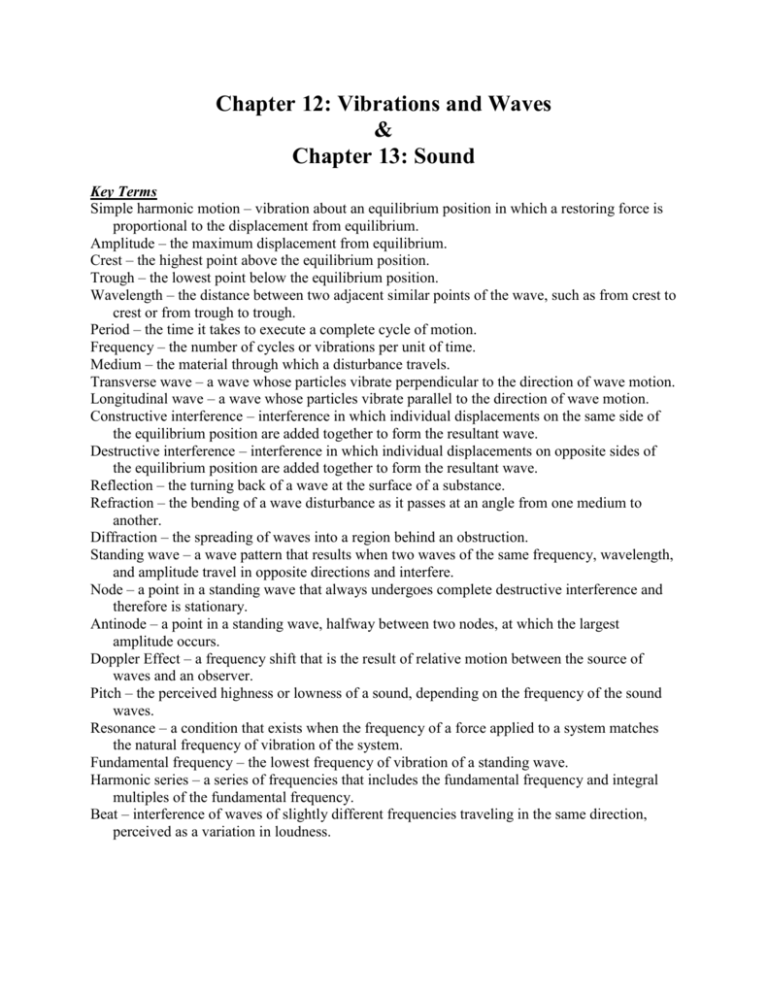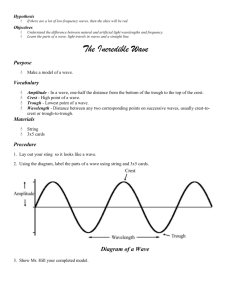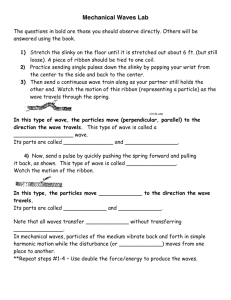Chapter 13
advertisement

Chapter 12: Vibrations and Waves & Chapter 13: Sound Key Terms Simple harmonic motion – vibration about an equilibrium position in which a restoring force is proportional to the displacement from equilibrium. Amplitude – the maximum displacement from equilibrium. Crest – the highest point above the equilibrium position. Trough – the lowest point below the equilibrium position. Wavelength – the distance between two adjacent similar points of the wave, such as from crest to crest or from trough to trough. Period – the time it takes to execute a complete cycle of motion. Frequency – the number of cycles or vibrations per unit of time. Medium – the material through which a disturbance travels. Transverse wave – a wave whose particles vibrate perpendicular to the direction of wave motion. Longitudinal wave – a wave whose particles vibrate parallel to the direction of wave motion. Constructive interference – interference in which individual displacements on the same side of the equilibrium position are added together to form the resultant wave. Destructive interference – interference in which individual displacements on opposite sides of the equilibrium position are added together to form the resultant wave. Reflection – the turning back of a wave at the surface of a substance. Refraction – the bending of a wave disturbance as it passes at an angle from one medium to another. Diffraction – the spreading of waves into a region behind an obstruction. Standing wave – a wave pattern that results when two waves of the same frequency, wavelength, and amplitude travel in opposite directions and interfere. Node – a point in a standing wave that always undergoes complete destructive interference and therefore is stationary. Antinode – a point in a standing wave, halfway between two nodes, at which the largest amplitude occurs. Doppler Effect – a frequency shift that is the result of relative motion between the source of waves and an observer. Pitch – the perceived highness or lowness of a sound, depending on the frequency of the sound waves. Resonance – a condition that exists when the frequency of a force applied to a system matches the natural frequency of vibration of the system. Fundamental frequency – the lowest frequency of vibration of a standing wave. Harmonic series – a series of frequencies that includes the fundamental frequency and integral multiples of the fundamental frequency. Beat – interference of waves of slightly different frequencies traveling in the same direction, perceived as a variation in loudness. Key Equations Hooke’s Law Felastic=-kx spring force (N) = -[spring constant (N/m) * displacement (m)] Period T=t/cycles period (s) = time (s) / number of cycles of motion Frequency f=cycles/t period (Hz or sec-1) = number of cycles of motion / time (s) Inverse Relationship between Period and Frequency f=1/T or T=1/f Period of a Simple Pendulum in Simple Harmonic Motion T=2π√(L/g) period (s) = 2π * √[length (m) / free-fall acceleration (m/s2)] Period of a Mass-Spring System in Simple Harmonic Motion T=2π√(m/k) period (s) = 2π * √[mass (kg) / spring constant (N/m)] Speed of a Wave v=fλ speed of a wave (m/s) = frequency (Hz) * wavelength (m) Harmonic Series of Standing Waves fn=nv/2L frequency (Hz) = harmonic number * speed of waves (m/s) / [2 * length of string/pipe (m)] Notes








